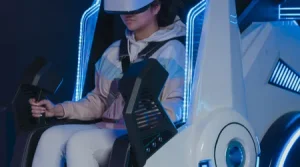How Virtual Reality Is Helping Patients with PTSD

Virtual reality is helping patients with PTSD, but it’s more than just a technological novelty. It’s a profound therapeutic tool. PTSD, or post-traumatic stress disorder, is a complex and often debilitating condition.
For millions, the world can feel overwhelming and unpredictable, a constant reminder of past trauma. But a new horizon is emerging. This technology is creating safe, controlled environments for healing.
The traditional approach to treating PTSD has its challenges. Exposure therapy, for example, is highly effective but can be incredibly difficult for patients.
It requires them to confront their fears and memories directly. This can be too intense for some individuals. The patient’s mind might resist the process.
Consequently, many people drop out of treatment early. This is where VR presents a transformative alternative. It allows for a more gradual, controlled exposure.
The patient remains in a secure setting, like a therapist’s office.
The Science Behind the Immersion
Virtual reality’s power lies in its ability to trick the brain. It creates a sense of “presence.”
This is the feeling of being in a different place. The user’s visual and auditory senses are completely engaged. This immersion is key to its therapeutic success.
Dr. Albert “Skip” Rizzo, a pioneer in this field, has been developing VR exposure therapy for years. His work, including the “Bravemind” system, has shown remarkable results.
The VR environment can be tailored to a patient’s specific trauma. A soldier might be taken back to a virtual battlefield. An accident survivor can re-experience a virtual crash scene.
This controlled re-enactment allows for a desensitization process. It helps to extinguish the fear response over time.
This isn’t just about reliving a memory; it’s about rewriting the emotional script. The brain learns that the environment is no longer a threat. This is a crucial step in recovery.
The therapist can pause the simulation at any moment. This offers a level of control that real-world exposure cannot. It empowers the patient and reduces the risk of being overwhelmed.
The patient is always in command, not the memory.
++ Virtual Reality in Courtrooms: Evidence Presentation and Training
The Therapeutic Bridge

Consider the experience of a firefighter struggling with PTSD. They might be tormented by a memory of a burning building. In the past, therapy might involve them verbally describing the scene.
With VR, they can virtually return to a similar environment. The therapist can adjust the smoke levels. They can control the sounds of crackling fire.
This gradual exposure helps the firefighter process the event. They can confront the triggers in a low-stakes environment.
Another powerful example involves survivors of natural disasters. A person who lived through a hurricane might have flashbacks. These are often triggered by wind or rain.
Using VR, they can be placed in a virtual environment with mild storms. The therapist can then increase the intensity. This controlled, safe re-exposure helps the brain re-learn safety.
It reduces the fear associated with the triggers.
This kind of guided exposure is a game-changer. It provides a unique bridge between avoidance and confrontation.
It’s like teaching someone to swim in a shallow, controlled pool before throwing them into the ocean. The psychological distance afforded by the headset is powerful.
Beyond Exposure: A Broader Spectrum of Healing
Virtual reality is helping patients with PTSD in more ways than just exposure therapy. It’s also being used for relaxation and mindfulness. Imagine a patient in a stressful moment.
They can be transported to a serene virtual forest. Or they can be placed on a tranquil beach. These virtual retreats can help regulate the nervous system.
They can provide a sense of calm and safety. This is particularly useful for patients with high anxiety.
Mindfulness-based VR applications are also gaining traction. They guide users through meditation exercises. The immersive nature of VR can reduce distractions.
It helps the user focus inward. This can be a vital skill for managing flashbacks. It’s about building new, positive neural pathways.
There is also a growing body of evidence supporting its efficacy. A 2023 study published in the journal Frontiers in Virtual Reality found that VR-based exposure therapy significantly reduced PTSD symptoms in veterans.
++ How VR Is Empowering Autism Therapy and Social Learning
The study reported a 65% reduction in symptom severity. This is a compelling indicator of its potential.
| Aspect of VR Therapy | Clinical Benefit |
| Immersion & Presence | Enhances emotional engagement, reduces detachment |
| Customization | Allows for tailored, personalized therapeutic scenarios |
| Gradual Exposure | Reduces patient drop-out rates due to intensity |
| Safety & Control | The therapist can pause or stop the session anytime |
| Biofeedback Integration | Measures patient’s physiological responses for deeper insight |
The Human Element in a Digital World
Despite the technology, the human connection remains vital. The VR headset is a tool, not a replacement for the therapist. The guidance and support of a trained professional are indispensable.
They interpret the patient’s reactions. They offer encouragement and perspective. Virtual reality is helping patients with PTSD by enhancing, not replacing, the therapist-patient relationship.
This technology allows for a new kind of dialogue. The therapist and patient can discuss the experience in real-time. They can analyze the emotional and physiological responses.
This partnership is what makes the therapy so effective. It’s about leveraging technology to deepen human understanding and empathy.
++ VR in Real Estate: Virtual Tours and Smart Sales
So, how can something so digital be so deeply human?
It’s because the experience it creates is real for the mind. It’s a tool for confronting trauma, for building resilience, and for finding a path back to a meaningful life.
The future of mental health treatment is not just about medication or talk therapy. It’s about innovative, empathetic solutions that meet patients where they are.
Virtual reality is helping patients with PTSD and is a testament to this evolving landscape.
Conclusion
The intersection of technology and mental health is promising. VR is showing that a virtual world can lead to real-world healing.
It provides a sanctuary for the mind. It allows patients to confront their demons on their own terms. This is a powerful shift in the treatment of PTSD. The journey is far from over, but the path is becoming clearer. Virtual reality is helping patients with PTSD discover new hope.
Frequently Asked Questions
1. Is VR treatment for PTSD accessible?
Accessibility is improving as the technology becomes more affordable. Many hospitals and specialized clinics now offer this type of treatment. Costs can vary depending on health insurance plans and location.
2. Is VR therapy safe for all patients?
VR therapy is generally safe, but a mental health professional should always evaluate each patient’s condition before beginning treatment.
The therapy is conducted in a controlled environment, which minimizes risks.
3. How long does it take to see results with VR therapy?
The duration of treatment varies from person to person. Some patients may see improvements after just a few sessions.
However, a complete course of treatment typically requires several weeks or months to have a lasting effect.
